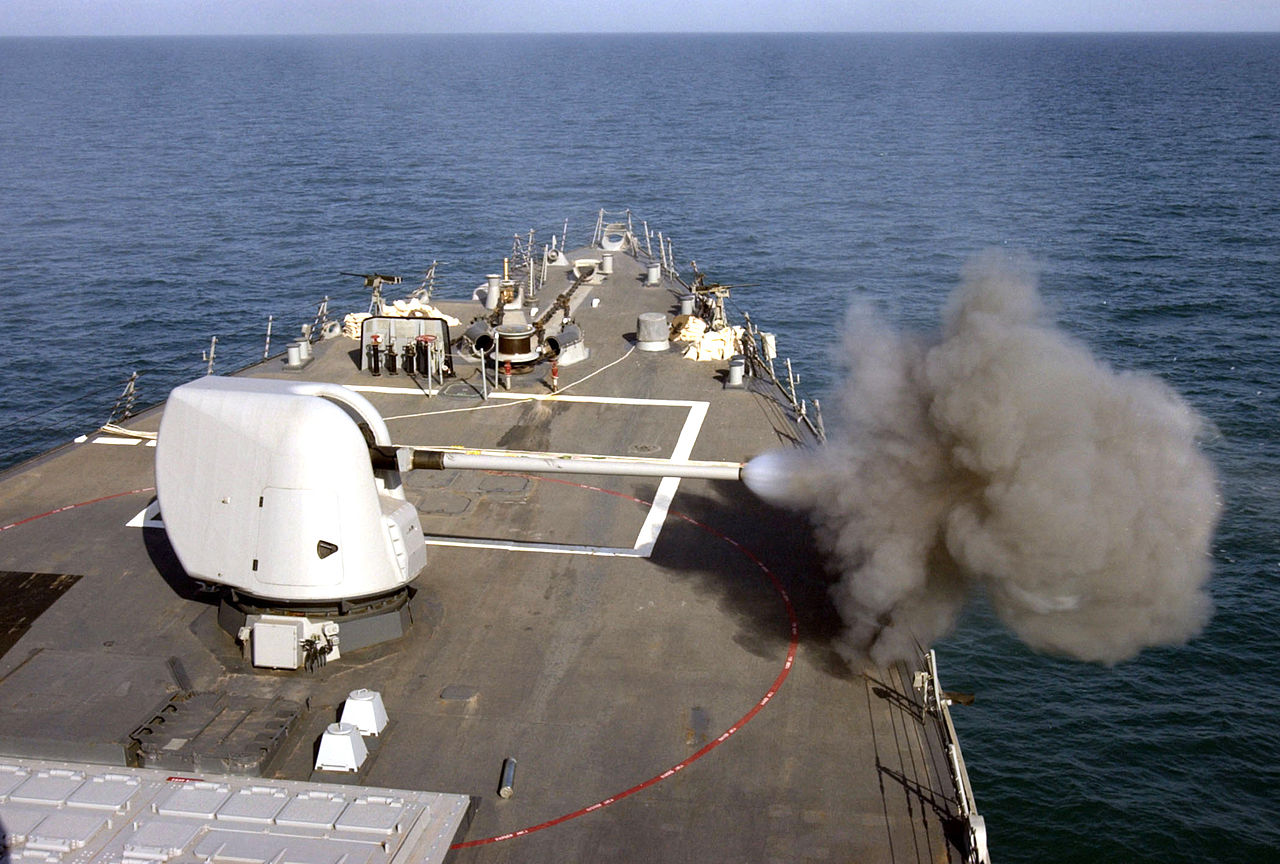Gone are the days of the heavy battleship and cruisers, with guns, guns, guns to bear. In the age of missiles do main guns still have a purpose on a naval vessel. I believe you already know the answer, as most naval vessels still have a main gun of some description. In my last article we talked about the heavy machine gun this time lets look at the main gun.
Depending on the size of vessel depends on the size of the gun the vessel may, another words, an OPV for example is probably not going to have a 127mm or 5" main gun, but she may have the 40mm bofors or 25-30mm Typhoon auto cannon.
A modern corvette are usually armed with medium and small-calibre guns, frigates medium to the larger 127mm or 5" main gun. A modern destroyer and cruisers guns are typically not really going to get much bigger than that. For example the 5"/54 caliber Mark 45 Naval gun is a standard gun used by many navies from the US Navy to the Australian and New Zealand Navy. You will see guided missile destroyers and cruisers with them and on the odd occasion possibly a second, though these are now very rare.
With modern radars and fire control systems these guns can be very accurate but a standard shell is limited in range typically around 20 km. However on saying this a non-standard shell up to 100 kilometres (62 mi) when using rocket-boosted, terminal guided "Vulcano GLR" rounds. We add in to this the future with railgun technology as well the range is also increased. However railguns require large amounts of power to charge the system.
So let's just talk about the standard modern gun what are the used for in today's world of missiles and fast jets.
With the right ammo the main gun can still be used in the anti-air role and as I said before with modern radars and fire controls are very accurate. With a fast jet doing a strafing run a the main gun could (in theory) take out the aircraft. As I said with the correct anti-air round that is causing a lot of flak.
However I already hear you say "please" and I am not saying that it will just saying it could. We will use HMNZS Te Kaha as an example enemy aircraft has fired its few missiles, Te Kaha's CAMM took out two of them and decoys, MASS Soft Kill, and Phalanx took care of the other two. She was lucky. The pilot decides to do a strafing run as a last ditch effort. We now have CAMM, Phalanx, and four HMG's and the main gun firing at the air-craft. CAMM would be the one most likely to do the job but not always. The idea is to put as much of a lead wall up for the aircraft to fly through. And to be fair the Phalanx will be the one the pilot is most wary of, to do a strafing run he will have a fair bit on his mind.
Again staying with anti-air and drones, many drones are slower than fast jets, although there are new technologies in this area as well. But your long range maritime drone is not that fast, or even a drone launched from an enemy vessel could easily get shot out of the sky with the main gun.
Anti-ship. Again in todays world of missiles gun battles are not likely to happen but you still have to train for this as if all your missiles get shot down or deflected by decoys and you come with in gun range that is the next layer of defence. So simple put you would at this stage have a good old gun battle, as well as missiles flying everywhere.
The main gun is good for troop support and shore bombardment in support of amphibious operations. Depending how close the the ship is to shore she can fire salvo's inland 10-15k or more. The troops will have a spotter and will be able to guide the gunfire support in since the ship is technically firing blind and only have a rough idea where those rounds are needed.
Since we have talked about wartime scenario's the can also be used as part of a blockaides and patrols like with the heavy machine guns, used to for firing across the bow to stop a civilian vessel, and if need to sink it for whatever reason, a few rounds is a lot cheaper than a million dollar missile.

Illumination rounds can be fire into the air to get visuals which can be used for a variety of things from night search and rescue to man overboard, to target marking.
A modern illumination shell has a time fuze that ejects a flare 'package' through the base of the carrier shell at a standard height above ground (typically about 600 metres), from where it slowly falls beneath a non-flammable parachute, illuminating the area below. The ejection process also initiates a pyrotechnic flare emitting white or 'black' infrared light.
A typical illumination flare burns for around 60 seconds. These are also known as starshell or star shell. Infrared illumination is a more recent development used to enhance the performance of night vision devices. Both white and black light illuminating shells may be used to provide continuous illumination over an area for a period of time, and may use several dispersed aimpoints to illuminate a large area. Alternatively firing single illuminating shells may be coordinated with the adjustment of HE shell fire onto a target.
Colored flare shells have also been used for target marking and other signaling purposes.
So you can see the naval gun still has its uses and will be around for a while yet as new technologies come online with new types of shells that fire from a standard naval gun.






